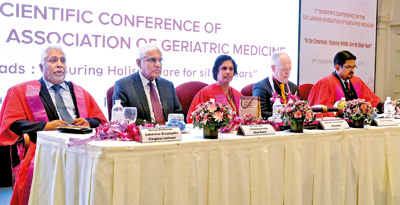News
All aspects of the Silver Age on SLAGM agenda
The Silver Age – each and every aspect to keep all those who are in this rapidly-growing group healthy and well, will be the focus of the Sri Lankan Association of Geriatric Medicine (SLAGM) this weekend.

Dr. Padma Gunaratne
The two-day 5th Annual Scientific Conference on the theme ‘At the crossroads – Ensuring holistic care for the Silver Years’ was inaugurated last morning at the Galle Face Hotel, Colombo, with the Governor of the Central Bank, Dr. Indrajit Coomaraswamy as the Chief Guest and consultant geriatrician Dr. Duncan R. Forsyth from the Cambridge University Hospitals Foundation, United Kingdom, as the Guest-of-Honour.
The congress lecture on the timely topic of ‘Feminization of Old-Age Morbidity in Sri Lanka’ was delivered by Senior Professor Lakshman Dissanayake, chair professor of demography, University of Colombo.
A highlight of the inauguration was the launching of the book, Healthcare for Older People – Holistic Approach – Stability & Mobility.
Taking time off her busy schedule, SLAGM President and consultant neurologist, Dr. Padma Gunaratne told the Sunday Times on Wednesday that the objective of holding an extensive conference was to uplift the standard of care given to the elderly in Sri Lanka.
“There is an exponential rise in the elderly population which was 12% in 2012. The pace of this rising trend is on par with developed countries,” said Dr. Gunaratne, reiterating that it is essential for the health sector to step up the availability of services for older people. The room for improvement is vast, particularly for the ‘old-old’ (80 years and above) category with regard to the delivery of day-to-day care. The other two categories are ‘young-old’ (60-69 years) and ‘middle-old’ (70-79 years).
Pointing out that the increase in the elderly population is mainly in the old-old category, she said that it is important to keep in mind that elders are a diverse group and all elders are not frail, dependent or ill and can contribute to the economy at national and family level, directly or indirectly. However, there is a small minority who account for a larger use of the health services and health is a right of older people, similar to everyone else.
Dr. Gunaratne reiterated the importance of teamwork in elderly care and added that the definition of health is “a state of complete physical, mental, social and spiritual well-being and not merely an absence of disease or infirmity”.
In his congress lecture, the excerpts of which are in the SLAGM’s abstract book, Senior Prof. Lakshman Dissanayake pointed out that typically mortality indicators have been used to evaluate the general state of health of a population. These indicators usually highlight life expectancy as one of the best indicators because it is not influenced by a population’s age structure. Hence it can be used to compare the health state between populations and also to monitor the impact of different interventions in health aspects.

The eminent personalities at the head-table ((from the left): Senior Professor Lakshman Dissanayake who delivered the Congress Lecture; Central Bank Governor and Chief Guest Dr. Indrajit Coomaraswamy; SLAGM President Dr. Padma Gunaratne; Guest-of-Honour Dr. Duncan R. Forsyth; and SLAGM Secretary Dr. Shehan Silva. Pix by Amila Gamage
“The increase in life expectancy is not only a characteristic of developed countries, having also shown a significant increase in developing countries, including Sri Lanka. The decline in mortality at young ages and the increase in longevity, combined with the decline of fecundity and the accentuated increase of degenerative chronic diseases, caused a rapid process of demographic and epidemiologic transition, imposing a new public health agenda in the face of the complexity of the new morbidity pattern,” he said.
Pointing out that it is a known fact that the likelihood of requiring long-term care increases beyond the age of 70, Senior Professor Dissanayake said that women are more likely to report disabilities and difficulties with self-care than older men, partly due to their greater longevity. Similarly, it appears that there is a significant decline in healthy life expectancy, inverting what had been a continuous growth process.
“This decline was particularly marked in Sri Lanka, with significant differences, more importantly, across gender: women tend to live longer, but spend more years in bad health with respect to men. This suggests that Sri Lanka has been more in line with the ‘expansion of morbidity’ hypothesis, given that the number of years spent with at least one chronic disease has substantially increased. This adds a new dimension to ageing, which is the feminisation of old-age morbidity,” he added.
The SLAGM’s conference programme looks closely at the “giants” in geriatrics such as immobility, instability, incontinence and impaired intellect/memory, impaired vision, impaired hearing, ‘elderly care service models’ and ‘palliative care’.
The pre-congress workshops held on Friday at the National Epilepsy Centre of the National Hospital of Sri Lanka (NHSL), were on ‘management of pain in the elderly’ mainly for doctors and ‘amputee rehabilitation and orthotic management of gait disorders of the elderly’, organised with expertise from Flinders Medical Centre, Bedford Park and New South Wales, Australia, for physiotherapists, occupational therapists, postgraduate doctors and consultants in rehabilitation medicine.
The book on Stability & Mobility, meanwhile, covers many crucial aspects from ‘gait patterns in older persons’ to ‘rheumatology of stability & mobility’ to ‘neurologic aspects of falls’ to ‘mood and cognitive causes affecting stability & mobility’ to ‘pharmacotherapy and falls’ to ‘the physiotherapist’s role in stability and mobility’ and to ‘the role of the occupational therapist in enhancing mobility and fall prevention’.
The SLAGM was founded by consultant rheumatologist Dr. Lalith Wijeyaratne in 2014 and its first President was consultant physician Dr. Dilhar Samaraweera.

